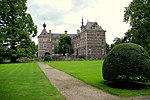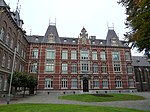Ében-Émael
Ében-Émael (French pronunciation: [ebɛn emal]; Walloon: Eben-Emål; Limburgish: Aemaol; Dutch: Eben-Emaal) is a village of Wallonia and a district of the municipality of Bassenge, located in the province of Liège, Belgium. The village is located on the French-speaking side of the language border, next to Kanne on the Flemish side and not far from the border with the Netherlands near Maastricht. It is located at an altitude of 70 metres (230 ft) above sea level. Until 1963, Eben-Emael belonged to the Dutch-speaking province of Limburg, but when the language border was established, the place was transferred to the province of Liège in Wallonia. It was a municipality in its own right before the 1977 Merger of Municipalities.
Excerpt from the Wikipedia article Ében-Émael (License: CC BY-SA 3.0, Authors).Ében-Émael
Rue Mathieu Chavée,
Geographical coordinates (GPS) Address Nearby Places Show on map
Geographical coordinates (GPS)
| Latitude | Longitude |
|---|---|
| N 50.783333333333 ° | E 5.6666666666667 ° |
Address
Rue Mathieu Chavée
Rue Mathieu Chavée
4690
Liège, Belgium
Open on Google Maps











